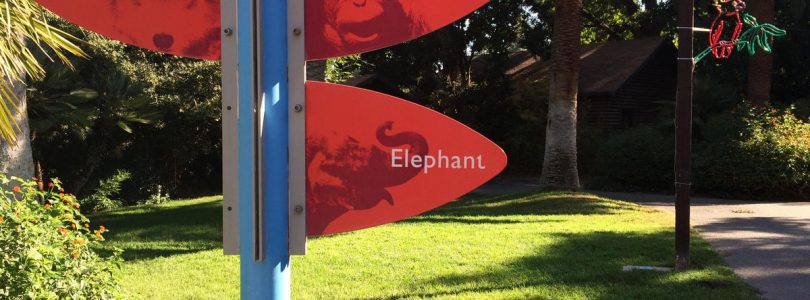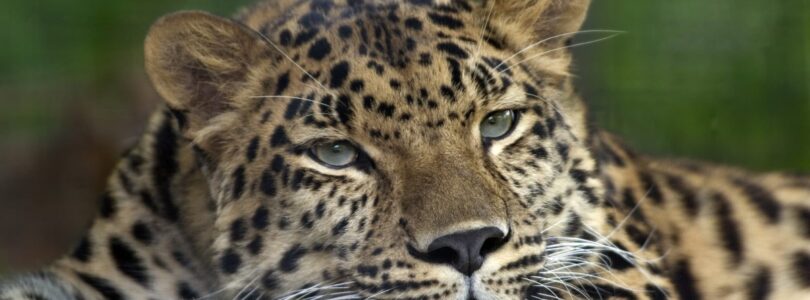Zoo Conservation
Zoo Conservation
Fitness Tracking for Elephant Welfare
Here’s an interesting take on wildlife welfare. It demonstrates promising results and may have implications for other animal habitats. Fitness tracking is all the rage right now. If you want to, you can monitor your heart rate, count your footsteps and calories burned, and even monitor your sleep patterns, all using devices that can fit around your wrist or in your pocket. But that’s if you’re a human. Kerry Klein takes us to the Fresno Chaffee Zoo, where fitness tracking is moving to a whole new level. Shaunzi used be a little overweight. But she got on an exercise routine and ditched the jelly beans for apples and carrots. She’s doing fine now; right around 6,000 pounds. She’s one of the Fresno Chaffee Zoo’s Asian elephants. Back in 2012, she wore a GPS tracker for a year as part of a multi-national research program. Now, lead elephant curator Vernon Presley tells me, that data is being used in another monitoring program to improve her and other elephants’ health. “We’ll get more concise information on body scoring, of how fit our elephants are,” he says, as well as “how much we time we spend with our elephants.” Shaunzi, the zoo’s four other elephants and their caretakers are now a part of the Elephant Welfare Initiative, a collaborative effort across North America to apply scientific data directly toward improving elephant care. Using a new software system, caretakers each day log what their elephants do, and then receive a report card with suggestions on how to enhance their routine. The whole initiative aims to improve the health and welfare of captive elephants—a population known to suffer more from obesity, foot problems and reproductive complications than their wild counterparts. Fresno Chaffee Zoo is one of 20 or so early adopters of the program. “We really feel this is what they call a lifestyle change in the elephant community,” says Presley. “We have to now commit even a greater amount of resources into monitoring our elephants’ behavior and how well we’re taking care of them.” The morning I visit the zoo, Shaunzi struts into her enclosure alongside the waterfall and heads straight to a network of chains and hanging objects. She reaches her trunk into a barrel above her head and shakes it until a cloud of hay rains down. It’s breakfast. She picks some off the ground and munches happily before reaching up again. Presley says she’s got a strategy. “If you had a box of M&Ms, you can pick one out at a time,” he says, “but if you pour the whole box of M&Ms out you can grab a whole handful and eat it.” Elephants enjoy working for their food. And new research says it’s good for them: for females, feeding challenges like this are actually correlated with better reproductive health. That’s the kind of data that the Elephant Welfare Initiative is based on. Evidence-based animal care may sound obvious, but wide-reaching data on captive animal populations is actually pretty rare. Studies tend to examine only a small number of elephants, or only a limited set of welfare indicators. Cheryl Meehan recognized this problem and wanted to do something about it. She’s the director of the AWARE Institute, a consulting organization that helps zoos improve their welfare practices. So in 2012, she worked with nearly 70 zoos to enroll over 250 elephants in an ambitious research program. That’s almost every elephant in every accredited zoo in North America. “It’s safe to say that this is the largest set of studies on zoo animal welfare that’s ever been conducted,” she says. For every one of those elephants, keepers strapped on GPS units, tracked vital signs, and analyzed foot and joint health. They collected blood and fecal samples, filled out detailed surveys about their elephants’ social groups, and some even monitored behaviors using video cameras. The result was 10 research articles published earlier this summer in the journal PLOS One. As expected, Meehan and her fellow researchers found that enclosures with soft sand and grass promoted healthy feet and joints. More surprising, however, was that bigger enclosures didn’t seem correlated with healthier elephants. When it came to socialization, elephants with more social opportunities demonstrated more positive indicators—like higher daily walking distance—and fewer negative ones—like so-called stereotypic behavior, in which an elephant sways back and forth or repetitively swings its trunk. “By supporting a social environment where animals are spending larger amounts of time in larger, stable social groups,” Meehan says, “we are not only supporting their natural behavioral biology but also providing a reduction in the risk of the development of these abnormal behaviors.” These quantitative connections are the foundation for the software system that gives feedback to participants in the initiative. “The metrics are basically automatically running and spitting out real-time information,” says Greg Vicino, an associate curator of elephants at San Diego Zoo Global and one of the initiative’s partners, “in this supercool-looking dashboard that said elephant manager or curator can sit at and look at and basically say, ‘okay, my social experience for the day was a 9 out of 10. What’s it going to take tomorrow for me to push that needle to a 10?’” But not everyone is excited about this initiative and its parent research. Kate Dylewsky of the advocacy group Born Free USA says the PLOS One studies confirm that elephants don’t belong in zoos at all. “They showed that elephants in zoos only walk 5.3 kilometers a day, whereas in the wild, African elephants can walk over 50 miles a day,” she says. “There were 25 percent with joint problems, 67 percent with foot problems, and then a whole host of reproductive issues.” Back at the Fresno Chaffee Zoo, Presley says elephant keepers are incorporating lessons learned from the research into their care. They’ve helped Shaunzi and fellow Asian elephant Kara each lose around 2,000 pounds. They’re varying the animals’ feeding habits. And they know their elephants would benefit from more social opportunities. Presley says they’re looking for a new home for Shaunzi and Kara so the two can mingle with a bigger herd of Asian elephants. As for the African elephants—Musi, Amy and Miss Betts—the zoo hopes they’ll create their own herd soon. Story courtesy of Valley Public Radio in Central California.
Effective and Funny Zoo Signage, Send Me Yours
In the study The Effect of Humor on Advertising Comprehension they find that “Prior investigations of the impact of humor on advertising message comprehension have generally found humorous commercials to be no more effective than comparable serious messages. This study re-examines humor’s influence by focusing on type of humor measurement (manipulated vs. perceived) and humor location in the advertisement. Findings indicate that humor (in the form of a one-line joke) does promote message comprehension, and offer support for information processing and operant conditioning explanations of the humor influence process.” At the bottom of the page you’ll find the article in its entirety. But for now, let’s enjoy those using humor to get their messages heard. Enjoy and please send in yours using the form at the bottom of the page.
ZooLex is a Robust Resource for the Zoo Professional
It looks like the site was designed in the 90s, the site could use some major updating, but the content is there. Particularly fun is the gallery of zoos. They break each Zoo down to size, maps, animals, cost, designer, conditions, plants, ect. It’s a nice overview look at how others organize themselves. From the ZooLex site About page: The ZooLex Zoo Design Organization: The ZooLex Zoo Design Organization is a non-profit organization, registered in Vienna (ZVR-Zahl 933849053), independent from companies and organizations. It relies on the support of subscribers, members, sponsors and well-wishers to fund its activities. Contact: Objectives: The ZooLex Zoo Design Organization was established to help improve holding conditions for wild animals in captivity by publishing and disseminating information related to zoo design, promoting appropriate holding conditions for wild animals in captivity, providing balanced technical information and advice about zoo design, and supporting research and vocational training related to zoo design. Partnership with WAZA: ZooLex provides a direct link to the WAZA website from its top navigation bar. The World Association of Zoos and Aquariums (WAZA) makes the ZooLex website available through www.waza.org and holds the ZooLex archive. WAZA’s mission is to guide, encourage and support the zoos, aquariums, and like-minded organisations of the world in animal care and welfare, environmental education and global conservation. The purpose of this partnership is to mutually support each other organization’s goal of promoting best practice in animal exhibit design. CHECK OUT THE ZOOLEX GALLERY HERE
TEST POST – Visitor Signage at the Museum of Contemporary Art San Diego
Here are a couple of pictures I took at the museum to help those with young visitors understand the museum’s expectation and how they advertise the FREE for those under 25 program. I’ve also included a projector per image as well as a general shot of the building. It’s set above the ocean front, it’s a beautiful place to be. Here is their ABOUT stuff: With two locations, the Museum of Contemporary Art San Diego (MCASD) is the region’s foremost forum devoted to the exploration and presentation of the art of our time, presenting works across all media created since 1950. Located in the heart of downtown San Diego and in the coastal community of La Jolla, MCASD provides an unprecedented variety of exhibition spaces and experiences for the community, showcasing an internationally recognized collection and a dynamic schedule of exhibitions and public programs. MISSION The mission of the Museum of Contemporary Art San Diego (MCASD) is to serve diverse audiences through the exhibition, interpretation, collection, and preservation of art created since 1950. MANDATE MCASD engages regional, national, and international audiences including the binational constituency of the San Diego/Tijuana region. VISION MCASD is a museum providing public access to contemporary art, artists, and the creative process; a forum for the exploration and understanding of contemporary art and ideas; and a laboratory for artists to experiment with new forms of creative expression.








